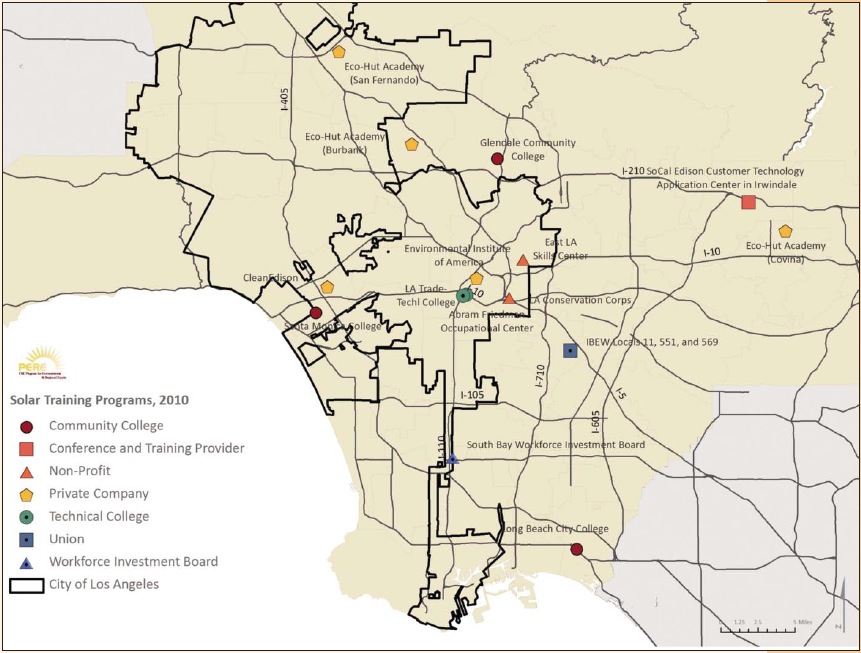LABC INSTITUTE
Executive Summary
Los Angeles is home to year-round sunshine and an entrepreneurial spirit. As such, it has the potential to be the national leader in solar power and clean energy jobs. Further, thanks to an abundance of training programs, Los Angeles boasts a trained workforce ready for jobs in solar installation, design, sales and more. Unfortunately, the Los Angeles Department of Water and Power (LA DWP) has failed to take advantage of the tremendous environmental and economic potential that solar power offers our region. As a result, Los Angeles has unwittingly forfeited significant opportunities to take leadership in this growing industry, meet the renewable energy goals mandated by state law, and create thousands of local jobs.
The UCLA Luskin Center has determined that a robust solar energy program in Los Angeles has the potential to create two billion dollars in local investment and 16,000 job-years with a minimal impact on ratepayers. Yet the LA DWP, the state’s largest municipal utility, has one of the most dismal track records in delivering results on solar power. In fact, an analysis demonstrates that LA DWP lags behind every major utility in the state when it comes to solar power capacity installed per customer. For example, LA DWP has generated less than one-sixth as much solar power per customer as Southern California Edison. Further, LA DWP is the least efficient utility at generating solar jobs, spending a total of $129,000 per job-year created.
The market for solar power generation in California expanded significantly in 2006, when Governor Arnold Schwarzenegger announced his “Million Solar Roofs” plan and the Governor and legislature accelerated their 20 percent Renewable Portfolio Standard (RPS) goal to be reached by 2010. The solar market in LA took a major step forward in 2008, when Mayor Antonio Villaraigosa called for one gigawatt (GW) of solar in Los Angeles 150, megawatts (mW) of which to be incentivized by a feed-in tarrif (FiT), a policy that allows ratepayers to generate solar on their rooftops and sell that energy back to the electrical grid. In 2009, a law authored by State Senator Gloria Negrete-McLeod, SB 32, required 750 mW of solar FiT in California. Now, Governor Jerry Brown has called for 12,000 mW of new renewable distributed generation energy in California, and he signed into law 33 percent RPS goals to be reached by 2020.
A private sector FiT program in Los Angeles is critical to leverage private investment in solar power, generate plentiful jobs, and allow LA DWP customers to use the 30 percent federal tax credits available for this effort. Implementation of a successful 75 mW FiT program in the 2012 budget, and a 150 mW FiT program by 2016 in Los Angeles, are necessary steps toward not only realizing our renewable energy goals, but driving economic development throughout the city. A coalition of environmental groups, labor leaders, business organizations and other stakeholders have come together to support such a program, yet, to date, LA DWP has not installed a single solar panel under a FiT. The utility has delayed its implementation for more than two years, and is now set to move forward with a misguided pilot program for six mW of solar, or one-fifteenth of the mandate under SB 32.
SB 32 provides a clear road map, and related mandates, for creating renewable energy in California. However, Senator Negrete-McLeod, recently wrote that LA DWP’s approach “ignores the intent behind the legislation and diminishes its potential.” Rather, the LA DWP has focused its attention on plans for large-scale solar installations in distant locations – plans that are, for the most part, still unrealized. This flawed approach fails to comply with state law and fails to take advantage of a huge potential generator of jobs and economic activity in Los Angeles, including in many “solar hotspots” in the San Fernando Valley, eastern Los Angeles, and areas west of downtown, including Hollywood.
In many cases, these hotspots are located in low-income areas where solar power potential and economic need directly overlap. They are also home to numerous training programs preparing workers for positions in the solar industry. In Los Angeles County alone, enrollment is estimated at 2,200 people a year in these programs, which are run by such varied organizations as Homeboy Industries, the LA International Brotherhood of Electrical Workers – Local 11/National Electrical Contractors Association, and the Los Angeles Trade and Technical College.
Unless civic leaders ramp up efforts to expand solar programs, the city and region face the prospect of being left behind, as other municipalities and other regions move forward on solar power and clean energy programs. In fact, while a recent study showed that one-quarter of all solar energy jobs in the nation are in California, there is a very real risk of those jobs (and others yet to be created) fleeing to other places. This report is, above all, a wake-up call to policymakers to make certain they are utilizing an important workforce segment – and creating policies that will put qualified people to work. In Los Angeles, the policy mandate is clear: the LA DWP must move forward swiftly on a comprehensive FiT program.
About the LABC Institute
www.labcinstitute.org
“To advance public education, build awareness and promote the development, expansion, and retention of affordable housing, clean technologies, public transportation, environmentally friendly business practices, and a skilled workforce.”
Tags: CA, California, Employment, LA, LABC, Los Angeles, Solar Energy







 RSS Feed
RSS Feed